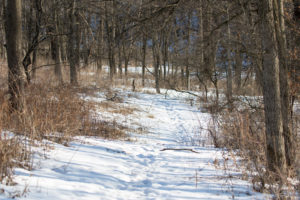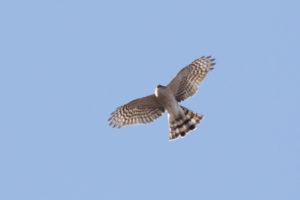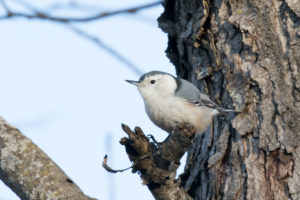What’s in a Name? February Birding at Turkey Creek Nature Preserve

Snow-covered path
Taking the time to watch and enjoy the crisp winter air, I hiked Turkey Creek Nature Preserve four times in February. I found the usual winter birds, with red-bellied woodpeckers being numerous and quite active.
The first signs of spring showed up on Feb 15th, when I saw several swarms of ethereal insects flying close to the ground. It was sunny and 41 degrees that day, but this observation was only 48 hours after it had been below zero degrees. I thought these wispy insects were an amazing sight. This was also the day that I first heard male northern cardinals singing. Birds sing to announce their territory and to attract mates, so it’s always fun to hear those first male birds showing off their vocals.

Sharp-shinned hawk
True signs of the coming spring appeared on Feb 22nd. Two larger flocks of American robins flew overhead going north. I counted 50 birds. Then I heard and saw a red-winged blackbird. Birds were quite active and busy and I had a lot of fun watching the white-breasted nuthatches looking for food in every nook and cranny on tree branches. My favorite sighting was of a sharp-shinned hawk. It soared right over me and I managed to get a few photos of this fun raptor. Sharpies (as birders call them) are smaller hawks, just barely larger than a blue jay. They hunt for small birds in the forest, so I don’t often get to see them soaring overhead.

White-breasted nuthatch
What’s in a name? Susan Spears, administrative assistant for Bur Oak Land Trust, contacted me after my January blog mentioned eBird to see about changing Turkey Creek’s hotspot name to indicate it was a Bur Oak Land Trust property. The eBird hotspot editor was kind enough to do this and now the property is listed in eBird as “Turkey Creek Nature Preserve, Bur Oak Land Trust.” This turned out to be more important than I realized at the time. The hotspot editor then brought together several sightings that had been done several years ago at Turkey Creek, but had been named something else. These past sightings added 23 species to the location in eBird bringing the total to 75 species. And then with my February hikes, I added rock pigeon. That’s the formal name for the everyday pigeon. The species count for Turkey Creek Nature Preserve in eBird now stands at 76.
I’ve found that taking the time to consistently get out to a property allows you to see seasonal changes in nature – whether it’s bird, pollinator, flower, or mushroom sightings. What have you found when you get outside?


